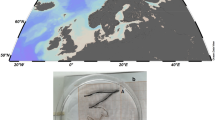Abstract
The frequency of litter overlap, the simultaneous presence of two litters at different stages of development within a single female, varies among populations of Gambusia hubbsi in different habitats on Andros, Bahamas. In freshwater bluehole and shallow water populations, less than 2% of the females carried two litters, independent of the difference in developmental stage between the litters. In well field populations, 2% of the females carried two litters composed of immature and mature oocytes, whereas 10% carried developing oocytes and late stage embryos, and 16% carried mature oocytes (or older) and late stage embryos. Among females from populations that we introduced into unoccupied well fields 2% carried two litters composed of immature and mature oocytes, about 14% carried developing oocytes and late stage embryos, and less than 6% carried mature oocytes (or older) and late stage embryos. When two litters composed developing oocytes and late stage embryos were present, the two litters were of equal size, and the total number of offspring was 1.5 times larger than expected on the basis of female body length. When two litters composed mature oocytes (or older stages) and late stage embryos were present, the two litters were also of equal size, and the total number of offspring was as expected on the basis of female body length. Litter overlap was independent of female size. A comparison of the consequences of litter overlap for strictly lecithotrophic and strictly matrotrophic modes of reproduction with the patterns of litter overlap observed in G. hubbsi, suggests that litter overlap in G. hubbsi reduces the cost of reproduction, but does not increase the rate of offspring production.
Similar content being viewed by others
References cited
Arias, A.L. & D. Reznick. 2000. Life history of Phalloceros caudiomaculatus: Anovel variation on the theme of livebearing in the family Poeciliidae. Copeia 2000: 792–798.
Burley, N.1980. Clutch size overlap and clutch size: alternative and complimentary reproductive tactics. Amer. Nat. 115: 223–246.
Downhower, J.F. & L. Brown. 1975. Superfoetation in fishes and the cost of reproduction. Nature 256: 345.
Downhower, J.F., L.P. Brown & M.L. Matsui. 2000. Life history variation in female Gambusia hubbsi. Env. Biol. Fish. 59: 415–428.
Haynes, J.L. 1995. Standardized classification of poeciliid development for life-history studies. Copeia 1995: 147–154.
Medlen, A.B. 1951. Preliminary observations on the effects of temperature and light upon reproduction in Gambusia affinis. Copeia 1951: 148–152.
Meisner, A.D. & J.R. Burns. 1997. Viviparity in the halfbeak genera Dermogenys and Nomorhamphus (Teleostei: Hemiamphidae). J. Morph. 234: 295–317.
Monaco, P.J., E.M. Rasch & J. Balsano. 1983 The occurrence of superfetation in the amazon molly, Poecilia formosa, and its related sexual species. Copeia 1983: 969–974.
Reznick, D.N., H. Callahan & R. Llandro. 1996. Maternal effects on offspring quality in poeciliid fishes. Amer. Zool. 36: 147–156.
Reznick, D.N & D.B. Miles. 1989. Review of life history patterns in poeciliid fishes, pp. 125–148. In: G.K. Meffe & F.F. Snelson (ed.) Ecology and Evolution of Livebearing Fishes (Poeciliidae), Prentice Hall, Englewood Cliffs.
Scrimshaw, N.S. 1944a. Superfetation in poeciliid fishes. Copeia 1944: 180–183.
Scrimshaw, N.S. 1944b. Embryonic growth in the viviparous poeciliid, Heterandria formosa. Biol. Bull. 87: 37–51.
Scrimshaw, N.S. 1945. Embryonic development in poeciliid fishes. Biol. Bull. 88: 233–246.
Scrimshaw, N.S. 1946. Egg size in poeciliid fishes. Copeia 1946: 20–23.
Thibault, R.E. 1974. Genetics of cannibalism in a viviparous fish and its relationship to population density. Nature 251: 138–140.
Thibault, R.E. 1975. Superfoetation in fishes and the cost of reproduction, a reply. Nature 256: 345–346.
Thibault, R.E. & R.J. Schultz. 1978. Reproductive adaptations among viviparous fishes (Cyprinodontiformes: Poeciliidae). Evolution 32: 320–333.
Travis, J., J.A. Farr, H. Sabine & R.T. Cheong 1982. Testing theories of clutch size overlap with the reproductive ecology of Heterandria formosa. Ecology 68: 611–623.
Trexler, J.C. 1997. Resource availability and plasticity in offspring provisioning: embryo nourishment in sailfin mollies. Ecology 78: 1370–1381.
Tuppen, G.D., C. Fairs, R.C. de Chazel & J.C. Konje. 1999. Spontaneous superfetation diagnosed in the first trimester with successful ouotcome. Ultrasound Obs. & Gyn. 14: 219–221.
Turner, C.L. 1937. Reproductive cycles and superfetation in poeciliid fishes. Biol. Bull. 72: 145–172.
Turner, C.L. 1940. Superfetation in viviparous cyprinodont fishes. Copeia 1940: 88–91.
Author information
Authors and Affiliations
Rights and permissions
About this article
Cite this article
Downhower, J.F., Brown, L.P. & Matsui, M.L. Litter Overlap in Gambusia hubbsi: Superfetation Revisited. Environmental Biology of Fishes 65, 423–430 (2002). https://doi.org/10.1023/A:1021151428795
Issue Date:
DOI: https://doi.org/10.1023/A:1021151428795




